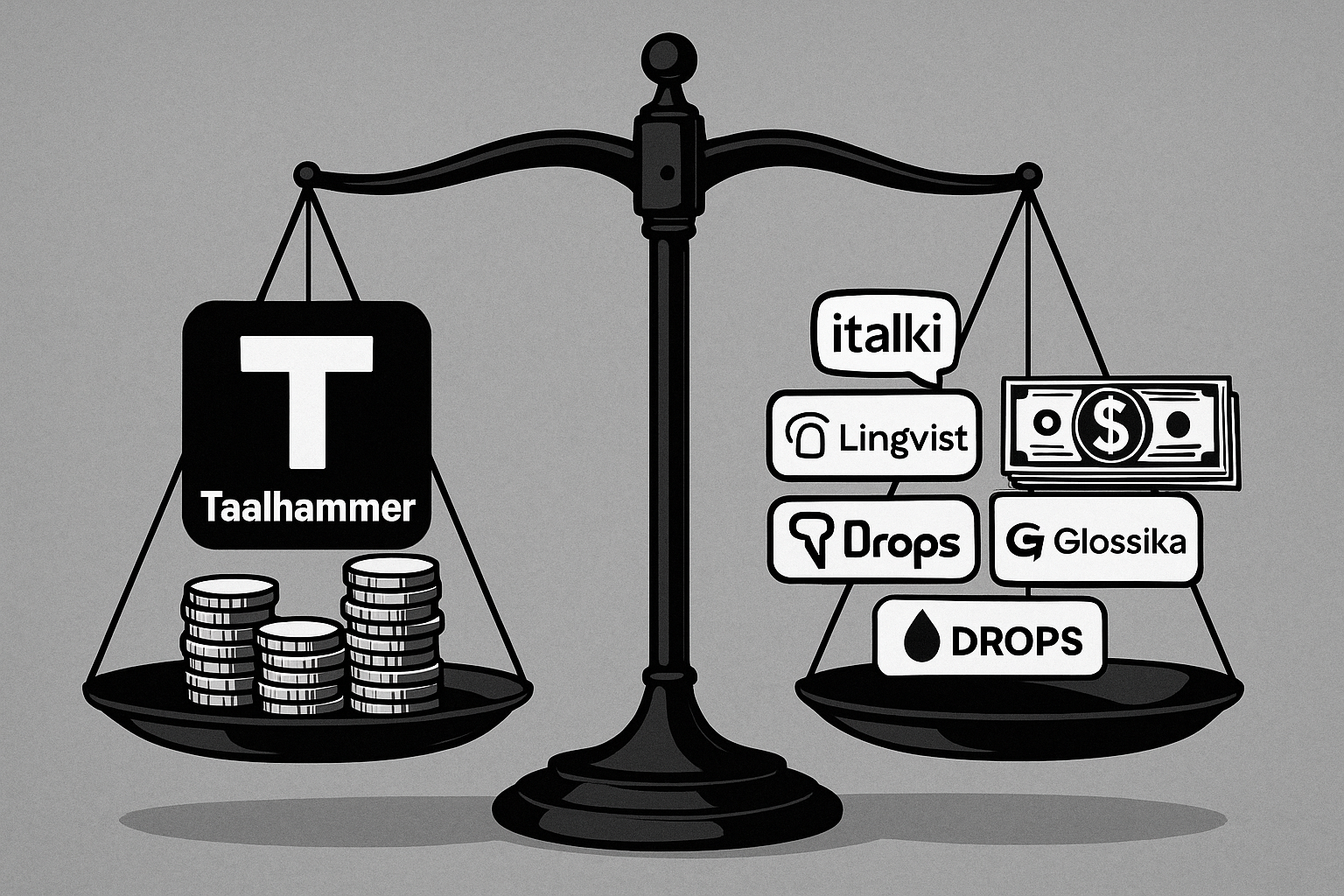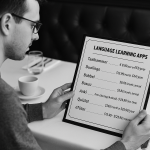In Part 1, we compared six of the most popular language learning apps by price, features, and trial periods. But when choosing a language learning app, cost alone doesn’t determine whether you’ll actually make real progress.
Here’s the real question: does paying for a language learning app help you stick with it? And if so, which payment models actually support long-term commitment and fluency?
In this follow-up, we’ll compare six more apps — Taalhammer, Italki, Lingvist, LingQ, Drops, and Glossika — through a different lens: not just what you pay, but how each app’s structure affects motivation, consistency, and real learning outcomes.
- Why Payment Matters in a Language Learning App
- How Do Different Language Learning Apps Build Commitment?
- How Pricing Affects Learning Habits
- What’s Behind the Paywall? What Do You Actually Get? Taalhammer vs Italki, Lingvist, LingQ, Drops and Glossika
- Transparency: Are There Any Hidden Costs?
- Which Language Learning App Fits Your Style?
- Choose Taalhammer if you want structure, AI, and full-skill fluency
- Choose Taalhammer or Italki if you want to actually speak the language
- Choose Taalhammer if you want to write and get feedback
- Choose LingQ if you want immersion through real content
- Choose Drops if you prefer short, visual bursts of vocabulary
- Choose Taalhammer of Glossika if you want audio repetition and speech pattern drilling
- Choose Taalhammer or Lingvist if you want to grow your vocabulary efficiently
- Why Commitment Wins in Language Learning
- FAQ: Choosing the Right Language Learning App
- Do I really need to pay for a language learning app to make progress?
- What makes Taalhammer different from other apps?
- Why do some apps feel better when they’re free?
- Which app is best if I want to practice speaking?
- Are there any hidden costs I should watch out for?
- Can I use more than one app at the same time?
Why Payment Matters in a Language Learning App
There’s a simple reason why users of free apps often quit after a few weeks: they have no skin in the game.
Behavioral studies show that even a small upfront payment increases consistency. You show up more often, push through harder lessons, and stick with your goals longer.
And in language learning, consistency is everything. Whether your goal is survival phrases or B2-level fluency, the right language learning app can help — but only if it encourages you to keep going. That’s where pricing matters more than you think.
How Do Different Language Learning Apps Build Commitment?
Every language learning app uses a different pricing model — and each model shapes how and when you commit. Here’s a side-by-side comparison:
| App | Price Model | Free Access |
|---|---|---|
| Taalhammer | €9.90/mo or €59/year | Full access for 7 days |
| Italki | Pay-per-lesson ($5–$25) | Fully free to browse |
| Lingvist | $9.99/mo or $79.99/year | 7-day trial |
| LingQ | $12.99/mo or $107/year | Free plan (limited use) |
| Drops | €5/mo or $149 lifetime | 5 min/day + ads |
| Glossika | $30.99/mo or $299/year | 7-day trial |
Apps like Taalhammer, Lingvist, and Glossika filter early: they give you a full experience, then ask you to commit. Others like LingQ and Drops take a freemium approach, while Italki offers flexible, pay-as-you-go learning.grade when ready.
How Pricing Affects Learning Habits
Every language learning app shapes your study behavior in its own way. Here’s how each payment system influences motivation:
Micro-subscriptions (Taalhammer, Drops)
Apps like Taalhammer and Drops use low monthly fees (around €4–5) to balance accessibility with accountability. You’re not breaking the bank, but you’ve invested just enough to show up regularly.
Taalhammer’s model goes further — you get full access for 7 days (no credit card needed), then you decide. No distractions, no endless freemium traps. This filters out dabblers and creates a serious, focused space that’s ideal for learners building long-term habits.
Drops, in contrast, starts fun and accessible but remains light. Even after upgrading, it focuses more on quick vocabulary bursts than on deeper learning structures.
Lesson-by-lesson (Italki)
With Italki, you pay when you book a lesson. There’s no algorithm or streak to nudge you — only your own intent. This model suits learners who prefer live, personal interaction, but it also requires more discipline since there’s no system to pull you back daily. Are you curious how many hours a week you should dedicate to learning if you choose Italki? Read the discussion and see for yourself.
Annual or higher-tier plans (Glossika, Lingvist)
Glossika and Lingvist expect bigger upfront commitments. Their content is structured and powerful — AI review in Lingvist, sentence-based fluency in Glossika — but the cost may intimidate new users. If you’re already serious, these systems deliver. If you’re just starting, the price might delay your habit-building.
Freemium with upgrade path (LingQ, Drops)
Freemium apps offer an easy start but limited long-term growth. LingQ restricts saved words and imports on the free plan; Drops caps you at five minutes per day unless you upgrade. They’re great for casual browsing, but users often hit a ceiling fast — and only those willing to pay move past it.
What’s Behind the Paywall? What Do You Actually Get? Taalhammer vs Italki, Lingvist, LingQ, Drops and Glossika
Choosing a paid language learning app isn’t just about removing ads. It’s about what you unlock — and whether those features actually help you learn better and faster.
| App | What You Get When You Pay |
|---|---|
| Taalhammer | Full access to AI-based spaced repetition, grammar integration, writing, listening, speaking practice, and structured progression. No ads, no fluff — just a serious system designed for real fluency. |
| Italki | Live, one-on-one tutoring with humans. Each session is tailored to your needs, with real feedback, conversation, and pronunciation help. Value depends on the tutor. |
| Lingvist | Unlocks all vocabulary decks, AI-driven repetition, grammar tips, and full access to every available language. Best for structured, fast-paced vocabulary building. |
| LingQ | Unlimited LingQs (saved vocab), audio lessons, offline access, and content imports. Essential if you want to build fluency through immersion. |
| Drops | Unlimited time, ad-free use, topic unlocking, and listening practice mode. Ideal for visual learners who want short, focused sessions without limitations. |
| Glossika | Access to full audio sentence database, speech drills, smart repetition, and fluency scoring across 60+ languages. High-intensity, high-commitment learning. |
Taalhammer stands out here for offering the broadest range of skills in one place — writing, listening, speaking, grammar, and AI-driven progress tracking — without locking core features behind extra tiers.
So… is it worth it?
- Taalhammer is designed for learners who actually want to get somewhere. You get full access for seven days — grammar, AI-based review, writing, listening, everything — and then it’s time to commit. There’s no noise, no distractions, no half-measures. It’s a focused system for people who are serious from the start — and that clarity can be exactly what keeps you moving forward.
- Italki is flexible and human-powered. You pay for each lesson, so the value depends on your tutor — but if real-time conversation is your goal, it’s one of the most direct ways to get speaking practice.
- Lingvist takes a data-driven approach, targeting vocabulary gaps with AI. But the real value kicks in only after you unlock the full system — and without that, the experience feels limited.
- LingQ is all about content immersion. Podcasts, books, and videos become learning materials — but only once you’ve upgraded. Until then, the free version feels more like a teaser than a tool.
- Drops is clean, visual, and habit-friendly. But the five-minute cap on the free version quickly gets in the way. If you upgrade, it becomes much more usable — especially for learners who like vocabulary bursts.
- Glossika offers a rigorous path to spoken fluency, with audio-heavy sentence drilling and spaced repetition. But there’s no real way to try it gradually — it’s either all in or not at all.
Transparency: Are There Any Hidden Costs?
At first glance, all six apps seem upfront about their pricing — but when you dig a little deeper, there are subtle differences in how transparent and predictable each one really is.
Let’s start with Italki. The platform itself is free to access, but the cost per lesson varies wildly depending on your tutor. Some community tutors offer lessons for as little as $5 an hour, while professional teachers may charge $25 or more. There’s no universal pricing — so the overall cost depends heavily on your personal choices. Great if you know what you’re looking for, but a bit unpredictable for beginners.
LingQ uses a tiered model. The Premium plan gives you access to most features, but if you want writing corrections, tutoring, or personalized feedback, you’ll need LingQ Points — which come at an additional cost. It’s a flexible system, but those extras can add up quickly if you rely on them regularly.
Glossika is fairly straightforward, but it’s worth noting that the student discount (which brings the price down significantly) requires verification through a third-party system. Not complicated — but not instant either.
In contrast, Taalhammer, Lingvist, and Drops keep things refreshingly simple. What you see is what you get.
- No tiers.
- No hidden features behind coins or points.
- No sudden upsells.
Whether you’re paying monthly, yearly, or choosing a lifetime plan, the structure is clear — and so is what you’re paying for.
Which Language Learning App Fits Your Style?
Every learner is different — and so is every language learning app. Some tools focus on one thing and do it well. Others, like Taalhammer, are built to cover multiple aspects of real, lasting fluency. Here’s how the apps align with different needs:
Choose Taalhammer if you want structure, AI, and full-skill fluency
If you’re serious about learning a language from the ground up — grammar, vocabulary, speaking, writing, and listening — Taalhammer brings all these elements together into one cohesive, focused system. Its AI-powered repetition and progression-based design help you retain more and stay on track long-term.
Choose Taalhammer or Italki if you want to actually speak the language
Italki gives you live one-on-one tutoring. Taalhammer helps you practice speaking daily through sentence-based drills and writing-to-speech practice — without needing to schedule or pay per session.
Choose Taalhammer if you want to write and get feedback
Unlike most apps in this list, Taalhammer includes writing practice as part of its core program, not as an afterthought. You learn to form and produce real sentences — not just tap multiple-choice buttons.
Choose LingQ if you want immersion through real content
LingQ is ideal for learners who like reading books and listening to native podcasts. You build vocabulary while consuming authentic input.
Choose Drops if you prefer short, visual bursts of vocabulary
Drops is made for fast, image-based memorization. Great for beginners and visual learners with limited time.
Choose Taalhammer of Glossika if you want audio repetition and speech pattern drilling
Glossika focuses on audio-heavy sentence training. Taalhammer also uses sentence-based input and spaced repetition — but adds grammar, writing, and adaptive review.
Choose Taalhammer or Lingvist if you want to grow your vocabulary efficiently
Lingvist focuses heavily on smart flashcards and rapid review. Taalhammer takes a broader approach — combining spaced repetition with real-world sentence exposure and grammatical patterns.
Why Commitment Wins in Language Learning
In this comparison of six language learning apps — Taalhammer, Italki, Lingvist, LingQ, Drops, and Glossika — you’ve seen that how you pay often shapes how you learn.
Free apps can get you started. But if you want real fluency, you’ll need structure, consistency, and commitment — and the right paid language learning app can give you all three.
Among the apps I’ve reviewed, Taalhammer offers something rare: an early commitment model that respects your time, avoids distractions, and focuses on fluency from day one. It’s not just affordable — it’s designed to work.
If you’re ready to move beyond casual learning, choose a language learning app that’s built for serious progress — and that means choosing the one that helps you show up, stay consistent, and finally speak the language you’ve been trying to learn.
FAQ: Choosing the Right Language Learning App
Do I really need to pay for a language learning app to make progress?
Not always — but it helps a lot. Free apps are great for getting started, but they often come with limits: ads, locked content, or no speaking/writing practice. Paying (even a little) usually gives you access to more serious tools — and more importantly, it helps you stick with it. Commitment is half the battle in language learning.
What makes Taalhammer different from other apps?
Taalhammer combines AI, grammar, speaking, writing, and listening in one focused platform. There’s no gamified fluff, no distractions — just a clean system built to help you actually learn and remember the language. It’s designed for people who aren’t just “trying out” a language, but who want to speak it fluently.
Why do some apps feel better when they’re free?
Because they’re fun! Apps like Duolingo or Drops are great at making learning feel like a game. That’s not bad — but if your goal is real fluency, you’ll eventually need more structure. That’s where paid apps (like Taalhammer, Glossika, or Lingvist) come in: they help you build a lasting habit and deeper knowledge.
Which app is best if I want to practice speaking?
If you want real-time conversation, Italki is the best for live tutoring.
But if you want to practice speaking and sentence-building daily — on your own time — Taalhammer includes speaking drills and sentence repetition that train your brain to speak naturally over time.
Are there any hidden costs I should watch out for?
Yes, in some apps.
- Italki lessons vary in price depending on the tutor.
- LingQ charges extra for tutoring points.
- Glossika has a student discount, but you have to apply for it.
Apps like Taalhammer, Lingvist, and Drops are more straightforward — what you pay is what you get, with no surprises.
Can I use more than one app at the same time?
Yes. Many learners mix tools. For example:
- Use Taalhammer for structured daily training
- Use Italki once a week for speaking
- Try LingQ for listening to podcasts or articles in your target language and later go back to Taalhammer and learn the new words using this app.
Just be careful not to spread yourself too thin. Consistency is more important than variety.








